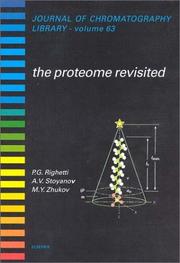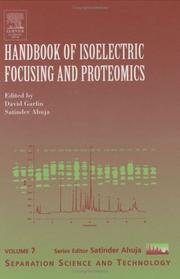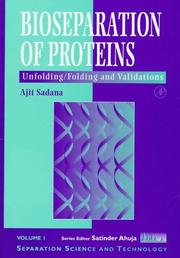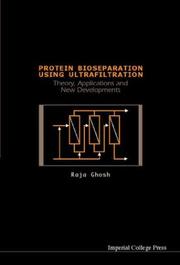| Listing 1 - 9 of 9 |
Sort by
|

ISBN: 0444505261 9780444505262 9780080518961 0080518966 1281048437 9786611048433 Year: 2001 Publisher: New York ; Amsterdam : Elsevier Science,
Abstract | Keywords | Export | Availability | Bookmark
 Loading...
Loading...Choose an application
- Reference Manager
- EndNote
- RefWorks (Direct export to RefWorks)
The book deals with the theory and practice of all electrophoretic steps leading to proteome analysis, i.e. isoelectric focusing (including immobilized pH gradients), sodium dodecyl sulphate electrophoresis (SADS-PAGE) and finally two-dimensional maps. It is a reasoned collection of all modern, relevant, up-to-date methodologies leading to successful fractionation, analysis and characterization of every polypeptide spot in 2-D map analysis. It includes chapters on the most sophisticated mass spectrometry developments and it helps the reader in navigating through the most important databases in
Fysicochemical separation methods --- Analytical biochemistry --- Proteins --- Electrophoresis. --- Cataphoresis --- Electrochemistry --- Phase partition --- Fractionation of proteins --- Protein fractionation --- Protein separation --- Resolution of proteins --- Separation. --- Fractionation --- Resolution

ISBN: 9780120887521 0120887525 9780080533629 0080533620 1281046299 9781281046291 9786611046293 Year: 2005 Publisher: Amsterdam Boston Elsevier Academic Press
Abstract | Keywords | Export | Availability | Bookmark
 Loading...
Loading...Choose an application
- Reference Manager
- EndNote
- RefWorks (Direct export to RefWorks)
Isoelectric focusing (IEF) is a high-resolution, stand-alone technique that can be used as an analytical method or tool for protein purification. The only current book on the market, the Handbook of Isoelectric Focusing and Proteomics is the ideal 'one-stop' source for germane information in this discipline. This highly practical book also contains chapters on alternative methods that may pave the way in the search for efficient techniques for fractionating and purifying proteins. Complete with the history of IEF focusing to authors' insights and practical tips, this book is a must fo
Isoelectric focusing. --- Proteins --- Proteomics. --- Molecular biology --- Fractionation of proteins --- Protein fractionation --- Protein separation --- Resolution of proteins --- Electrofocusing --- Focusing, Isoelectric --- Analytical chemistry --- Chemistry, Organic --- Electrophoresis --- Separation. --- Fractionation --- Resolution --- Qualitative

ISBN: 9780126140408 0126140405 9780080528144 0080528147 9786611038519 1281038512 Year: 1998 Publisher: San Diego : Academic Press,
Abstract | Keywords | Export | Availability | Bookmark
 Loading...
Loading...Choose an application
- Reference Manager
- EndNote
- RefWorks (Direct export to RefWorks)
This book covers the fundamentals of protein inactivation during bioseparation and the effect on protein processing. Bioseparation of Proteins is unique because it provides a background of the bioseparation processes, and it is the first book available to emphasize the influence of the different bioseparation processes on protein inactivation.Bioseparation of Proteins covers the extent, mechanisms of, and control of protein inactivation during these processes along with the subsequent and essential validation of these processes. The book focuses on the avoidance of protein (b
Proteins --- Protein folding. --- Folding of proteins --- Fractionation of proteins --- Protein fractionation --- Protein separation --- Resolution of proteins --- Biotechnology. --- Separation. --- Folding --- Conformation --- Fractionation --- Resolution

ISBN: 1281866784 9786611866785 186094938X 9781860949388 9781281866783 1860943179 9781860943171 Year: 2003 Publisher: London Imperial College Press
Abstract | Keywords | Export | Availability | Bookmark
 Loading...
Loading...Choose an application
- Reference Manager
- EndNote
- RefWorks (Direct export to RefWorks)
Ultrafiltration is a pressure-driven, membrane-based separation process, which is used for a broad variety of applications, ranging from the processing of biological macromolecules to wastewater treatment. It has significant advantages over competing separation technologies. Food and biotechnological applications account for nearly 40% of the current total usage of ultrafiltration membranes. Protein bioseparation is an important component of this application segment. Ultrafiltration is used for protein concentration, desalting, clarification and fractionation (i.e. protein-protein separation).
Proteins --- Ultrafiltration. --- Filters and filtration --- Permeability --- Fractionation of proteins --- Protein fractionation --- Protein separation --- Resolution of proteins --- Biotechnology. --- Separation. --- Fractionation --- Resolution --- General biochemistry --- Water supply. Water treatment. Water pollution --- Biotechnology --- biochemie --- waterverontreiniging --- biotechnologie --- afvalwater
Book
Year: 2020 Publisher: Basel, Switzerland MDPI - Multidisciplinary Digital Publishing Institute
Abstract | Keywords | Export | Availability | Bookmark
 Loading...
Loading...Choose an application
- Reference Manager
- EndNote
- RefWorks (Direct export to RefWorks)
Food processing by humans goes a long way back in time, e.g., heat for cooking was used 1.9 million years ago. However, meal preparation now seems to be moving out of the home kitchen, and preprocessed or processed/convenience food products are becoming a larger part of the daily diet. In addition, consumers are progressively focusing on the impact of food on their health, and they demand foods that have a high nutritional quality and an aroma and natural flavor that are similar to freshly-made products. Therefore, nutritional quality is concurrent with food safety, and sensory perception is becoming an increasingly important factor in food choices. The human digestive tract disintegrates food to allow the nutrients to be released and made available to the body. However, nutrients can undergo unwanted degradation upon processing and subsequent storage, negatively influencing the physiological effects. Different processing techniques will result in different food structures, thereby also affecting bioaccessibility and nutritional value. Hence, food scientists and industry have an increased interest in both conventional and innovative processing methods that can provide good-quality products with high nutritional value and stable shelf life. This Special Issue aims to shed some light on the latest knowledge about and developments within the effects of food processing and storage on changes of biochemical and nutritional compounds. Both original research articles and reviews are included in this book.
History of engineering & technology --- protein fractionation --- white teff --- brown teff --- amino acid profile --- seed storage proteins --- essential amino acids --- anthocyanins --- ascorbic acid --- UV-Vis --- HPLC-MS --- kinetics --- shelf life --- legume protein --- processing --- digestibility --- PEF --- OH --- POD --- colour --- extraction --- spray drying --- freeze drying --- antioxidants --- carotenoid aggregates --- coloring foods --- grouper --- refrigerated storage --- packaging methods --- protein oxidation --- protein degradation --- protein fractionation --- white teff --- brown teff --- amino acid profile --- seed storage proteins --- essential amino acids --- anthocyanins --- ascorbic acid --- UV-Vis --- HPLC-MS --- kinetics --- shelf life --- legume protein --- processing --- digestibility --- PEF --- OH --- POD --- colour --- extraction --- spray drying --- freeze drying --- antioxidants --- carotenoid aggregates --- coloring foods --- grouper --- refrigerated storage --- packaging methods --- protein oxidation --- protein degradation

ISBN: 1280043318 9786610043316 0306468689 0792357515 Year: 1999 Publisher: Dordrecht, Netherlands ; Boston, Massachusetts : Kluwer Academic,
Abstract | Keywords | Export | Availability | Bookmark
 Loading...
Loading...Choose an application
- Reference Manager
- EndNote
- RefWorks (Direct export to RefWorks)
It is a truism of science that the more fundamental the subject, the more universally applicable it is. Nevertheless, it is important to strike a level of “fundamentalness” appropriate to the task in hand. For -depth study of the mechanics of motor cars would tell one example, an in nothing about the dynamics of traffic. Traffic exists on a different “level” - it is dependent upon the existence of motor vehicles but the physics and mathematics of traffic can be adequately addressed by considering motor vehicles as mobile “blobs”,with no consideration of how they become mobile. To start a discourse on traffic with a consideration of the mechanics of motor vehicles would thus be inappropropriate. In writing this volume, I have wrestled with the question of the appropriate level at which to address the physics underlying many of the techniques used in protein isolation. I have tried to strike a level as would be used by a mechanic (with perhaps a slight leaning towards an engineer) - i.e. a practical level, offering appropriate insight but with minimal mathematics. Some people involved in biochemical research have a minimal grounding in chemistry and physics and so I have tried to keep it as simple as possible.
Proteins --- Separation. --- Biochemistry. --- Analytical biochemistry. --- Biotechnology. --- Chemistry. --- Biochemistry, general. --- Analytical Chemistry. --- Chemistry/Food Science, general. --- Analytical chemistry. --- Physical sciences --- Chemical engineering --- Genetic engineering --- Analysis, Chemical --- Analytic chemistry --- Chemical analysis --- Chemistry, Analytic --- Chemistry --- Biological chemistry --- Chemical composition of organisms --- Organisms --- Physiological chemistry --- Biology --- Medical sciences --- Composition --- Fractionation of proteins --- Protein fractionation --- Protein separation --- Resolution of proteins --- Fractionation --- Resolution
Book
Year: 2020 Publisher: Basel, Switzerland MDPI - Multidisciplinary Digital Publishing Institute
Abstract | Keywords | Export | Availability | Bookmark
 Loading...
Loading...Choose an application
- Reference Manager
- EndNote
- RefWorks (Direct export to RefWorks)
Food processing by humans goes a long way back in time, e.g., heat for cooking was used 1.9 million years ago. However, meal preparation now seems to be moving out of the home kitchen, and preprocessed or processed/convenience food products are becoming a larger part of the daily diet. In addition, consumers are progressively focusing on the impact of food on their health, and they demand foods that have a high nutritional quality and an aroma and natural flavor that are similar to freshly-made products. Therefore, nutritional quality is concurrent with food safety, and sensory perception is becoming an increasingly important factor in food choices. The human digestive tract disintegrates food to allow the nutrients to be released and made available to the body. However, nutrients can undergo unwanted degradation upon processing and subsequent storage, negatively influencing the physiological effects. Different processing techniques will result in different food structures, thereby also affecting bioaccessibility and nutritional value. Hence, food scientists and industry have an increased interest in both conventional and innovative processing methods that can provide good-quality products with high nutritional value and stable shelf life. This Special Issue aims to shed some light on the latest knowledge about and developments within the effects of food processing and storage on changes of biochemical and nutritional compounds. Both original research articles and reviews are included in this book.
History of engineering & technology --- protein fractionation --- white teff --- brown teff --- amino acid profile --- seed storage proteins --- essential amino acids --- anthocyanins --- ascorbic acid --- UV-Vis --- HPLC-MS --- kinetics --- shelf life --- legume protein --- processing --- digestibility --- PEF --- OH --- POD --- colour --- extraction --- spray drying --- freeze drying --- antioxidants --- carotenoid aggregates --- coloring foods --- grouper --- refrigerated storage --- packaging methods --- protein oxidation --- protein degradation --- n/a
Book
Year: 2020 Publisher: Basel, Switzerland MDPI - Multidisciplinary Digital Publishing Institute
Abstract | Keywords | Export | Availability | Bookmark
 Loading...
Loading...Choose an application
- Reference Manager
- EndNote
- RefWorks (Direct export to RefWorks)
Food processing by humans goes a long way back in time, e.g., heat for cooking was used 1.9 million years ago. However, meal preparation now seems to be moving out of the home kitchen, and preprocessed or processed/convenience food products are becoming a larger part of the daily diet. In addition, consumers are progressively focusing on the impact of food on their health, and they demand foods that have a high nutritional quality and an aroma and natural flavor that are similar to freshly-made products. Therefore, nutritional quality is concurrent with food safety, and sensory perception is becoming an increasingly important factor in food choices. The human digestive tract disintegrates food to allow the nutrients to be released and made available to the body. However, nutrients can undergo unwanted degradation upon processing and subsequent storage, negatively influencing the physiological effects. Different processing techniques will result in different food structures, thereby also affecting bioaccessibility and nutritional value. Hence, food scientists and industry have an increased interest in both conventional and innovative processing methods that can provide good-quality products with high nutritional value and stable shelf life. This Special Issue aims to shed some light on the latest knowledge about and developments within the effects of food processing and storage on changes of biochemical and nutritional compounds. Both original research articles and reviews are included in this book.
protein fractionation --- white teff --- brown teff --- amino acid profile --- seed storage proteins --- essential amino acids --- anthocyanins --- ascorbic acid --- UV-Vis --- HPLC-MS --- kinetics --- shelf life --- legume protein --- processing --- digestibility --- PEF --- OH --- POD --- colour --- extraction --- spray drying --- freeze drying --- antioxidants --- carotenoid aggregates --- coloring foods --- grouper --- refrigerated storage --- packaging methods --- protein oxidation --- protein degradation --- n/a
Periodical
Abstract | Keywords | Export | Availability | Bookmark
 Loading...
Loading...Choose an application
- Reference Manager
- EndNote
- RefWorks (Direct export to RefWorks)
Proteins --- Bioinformatics --- Protéomique --- Bioinformatics. --- Proteome. --- Separation --- Separation. --- Genome. --- genetics. --- Fractionation of proteins --- Protein fractionation --- Protein separation --- Resolution of proteins --- Bio-informatics --- Biological informatics --- Genomes --- Proteomes --- Proteids --- Fractionation --- Resolution --- Proteome --- Genome --- genetics --- Gene Products, Protein --- Gene Proteins --- Protein Gene Products --- Proteins, Gene --- Biology --- Information science --- Computational biology --- Systems biology --- Biomolecules --- Polypeptides --- Proteomics --- Genes --- Data processing --- Molecular Mechanisms of Pharmacological Action --- Protein --- Genomes. --- Protéines --- Bio-informatique --- Protéomes. --- Génomes. --- Séparation --- Genetics --- Genomics --- Haploidy --- Proteomics. --- Molecular biology
| Listing 1 - 9 of 9 |
Sort by
|

 Search
Search Feedback
Feedback About UniCat
About UniCat  Help
Help News
News